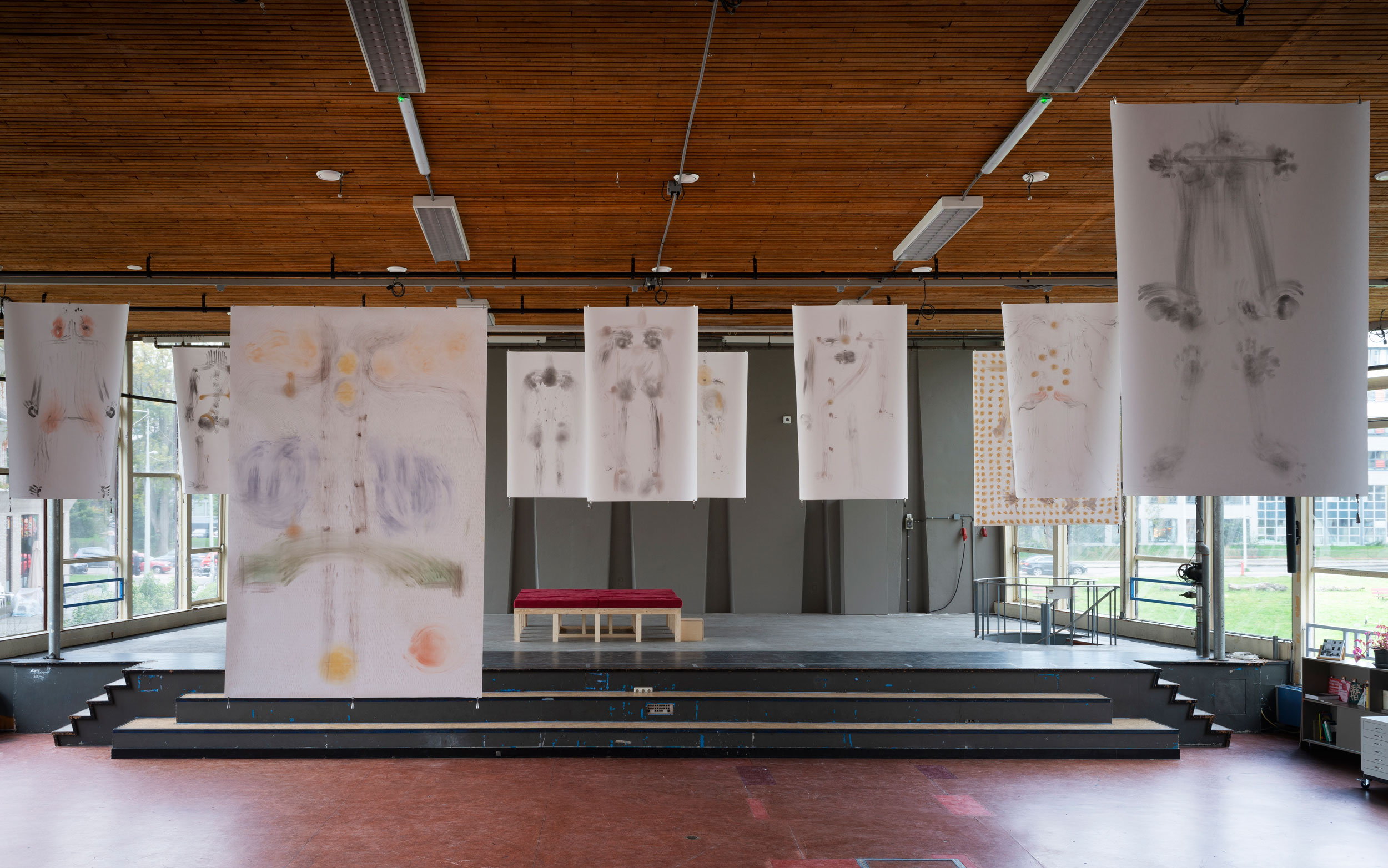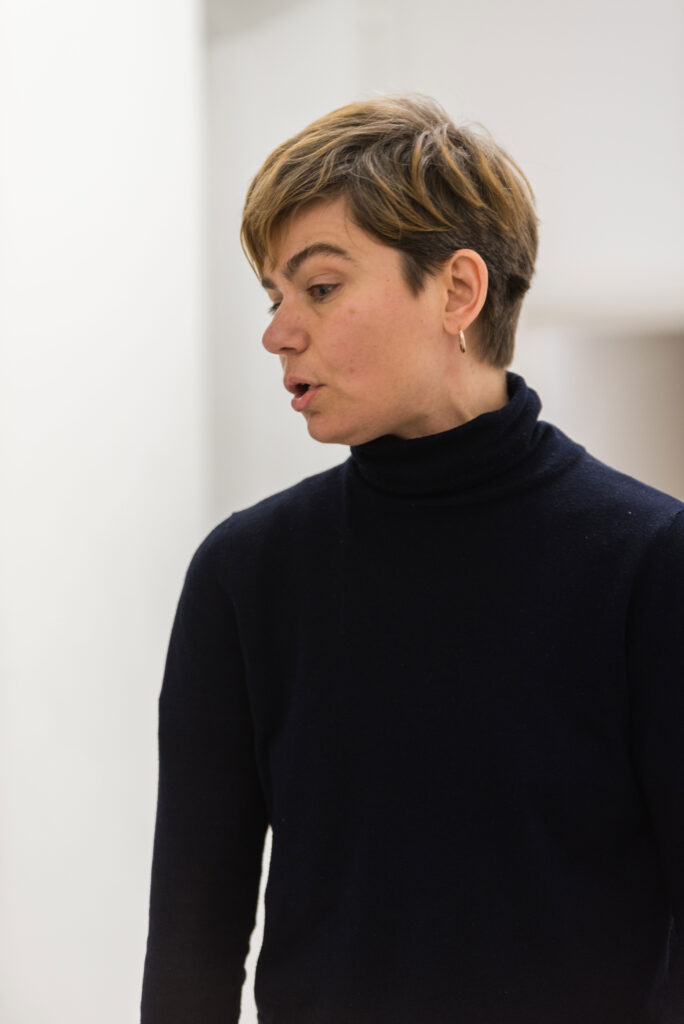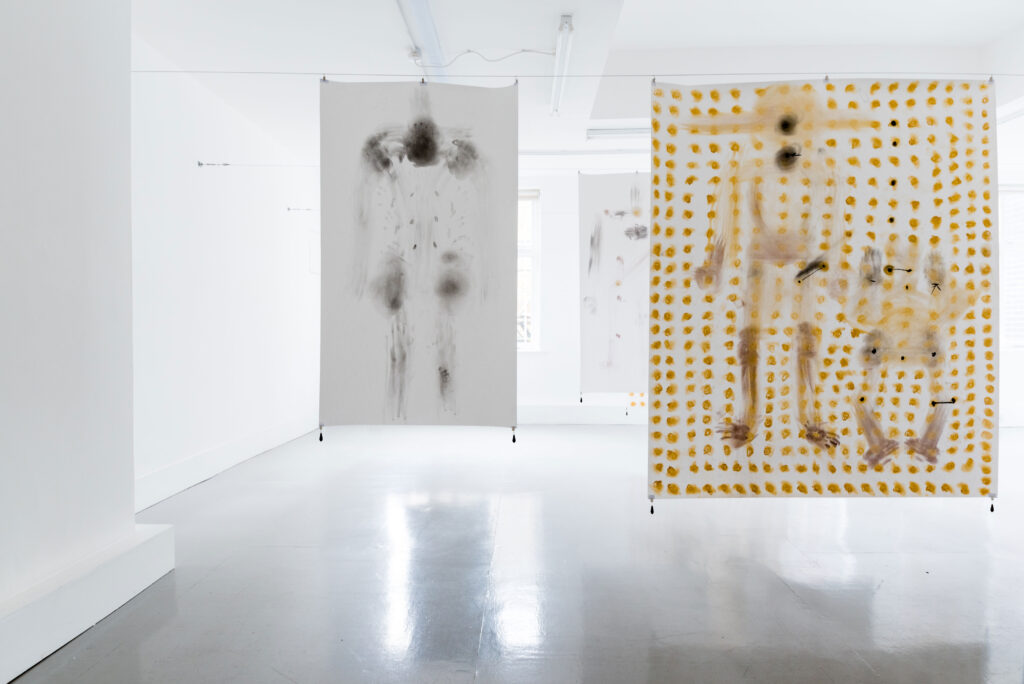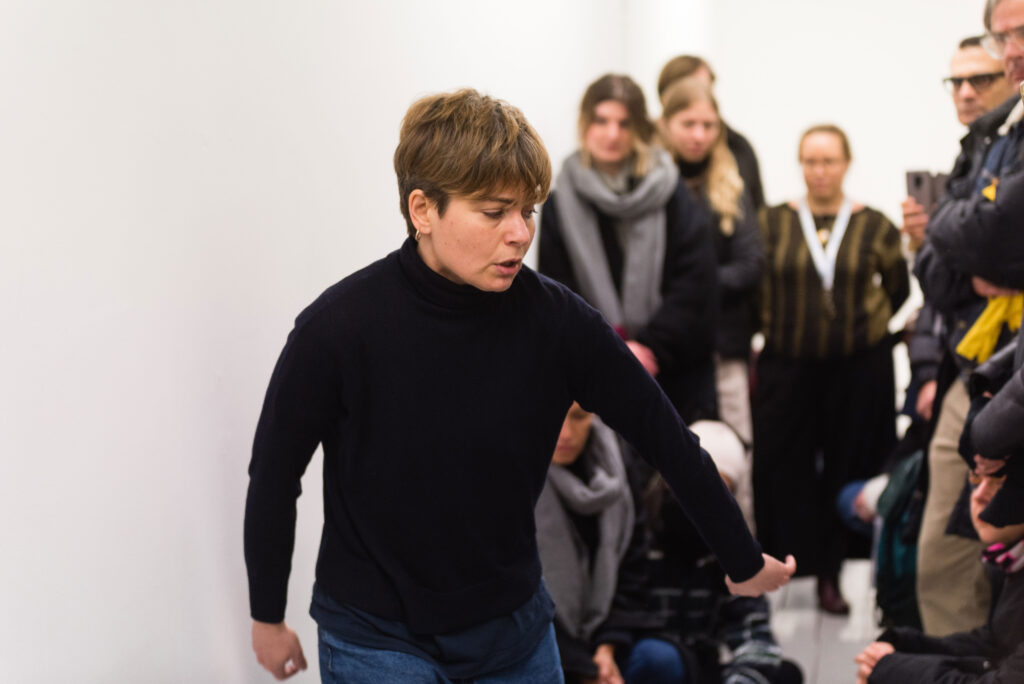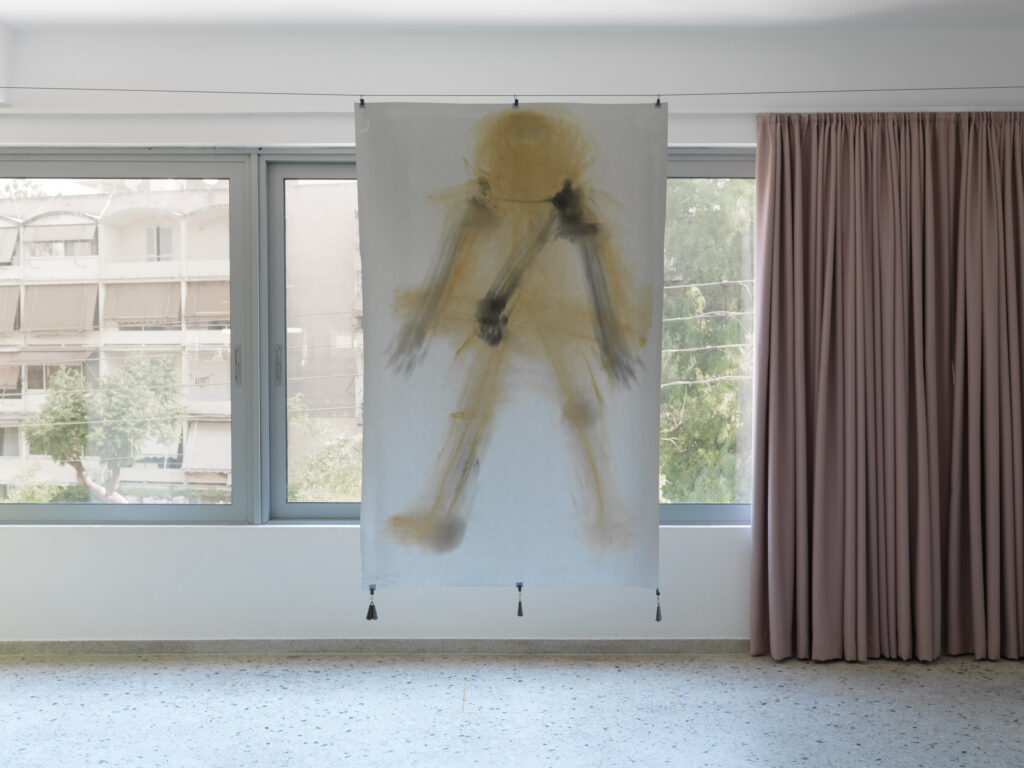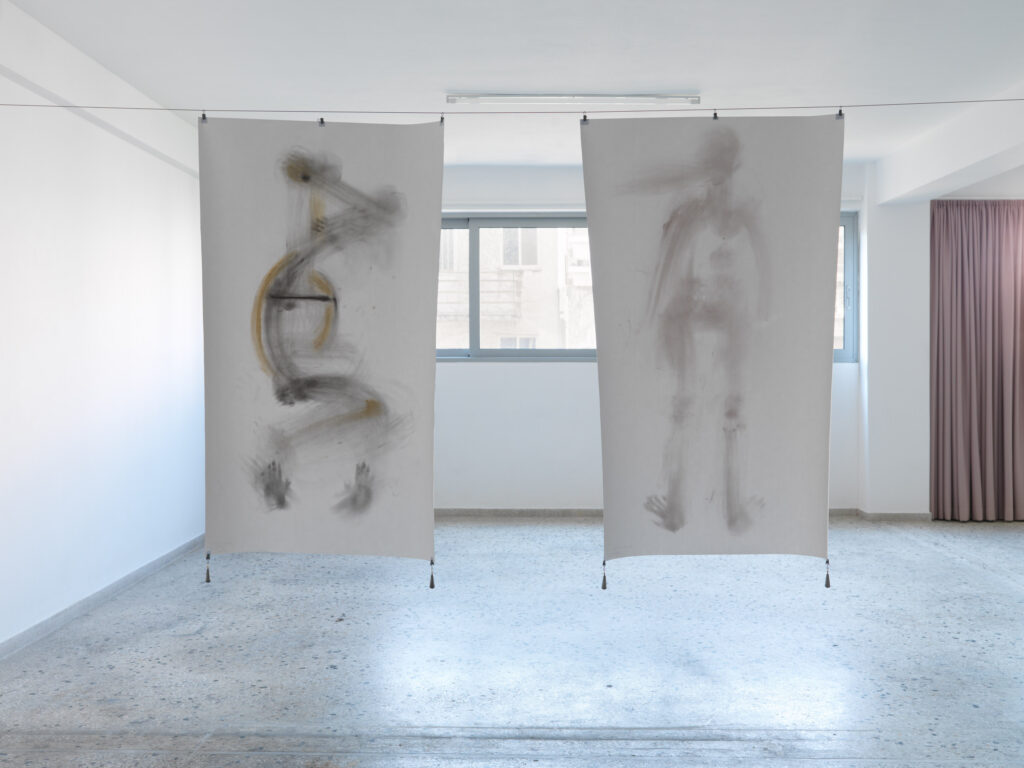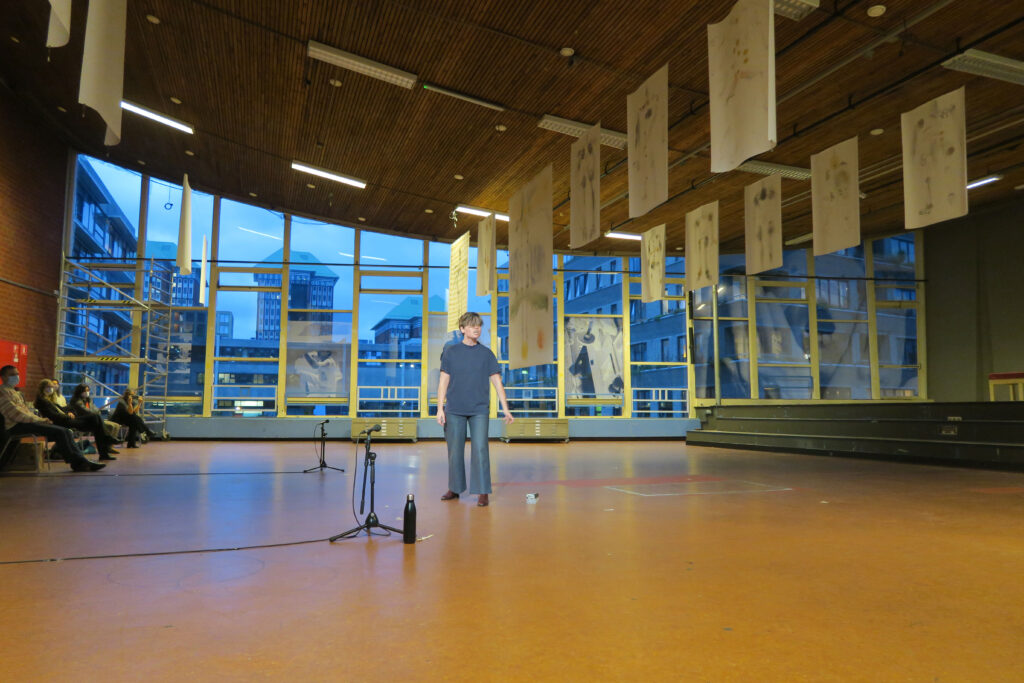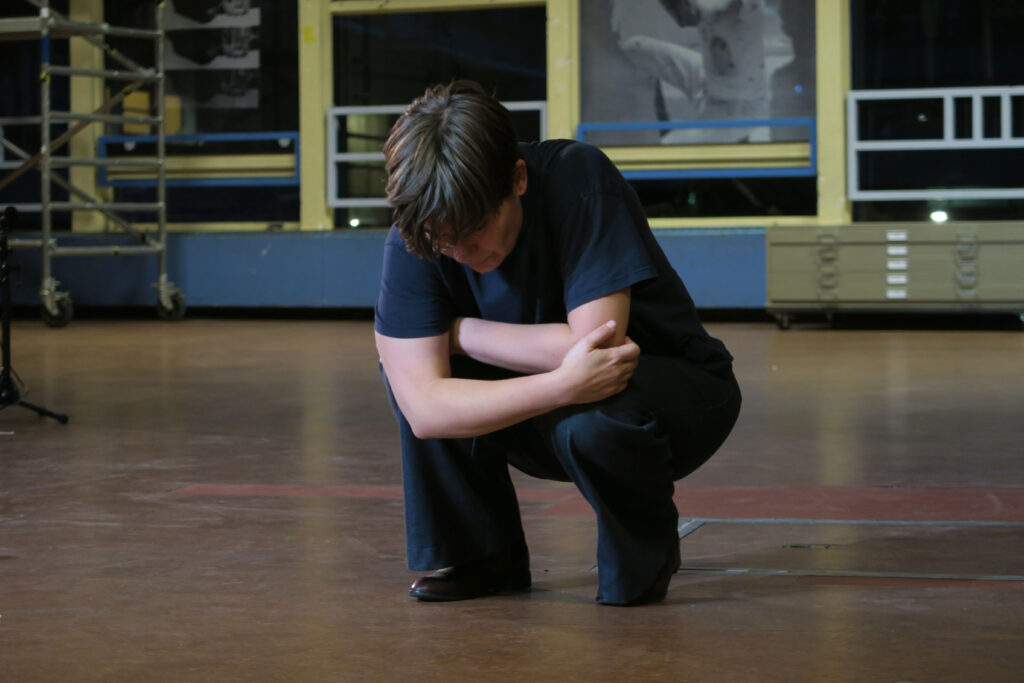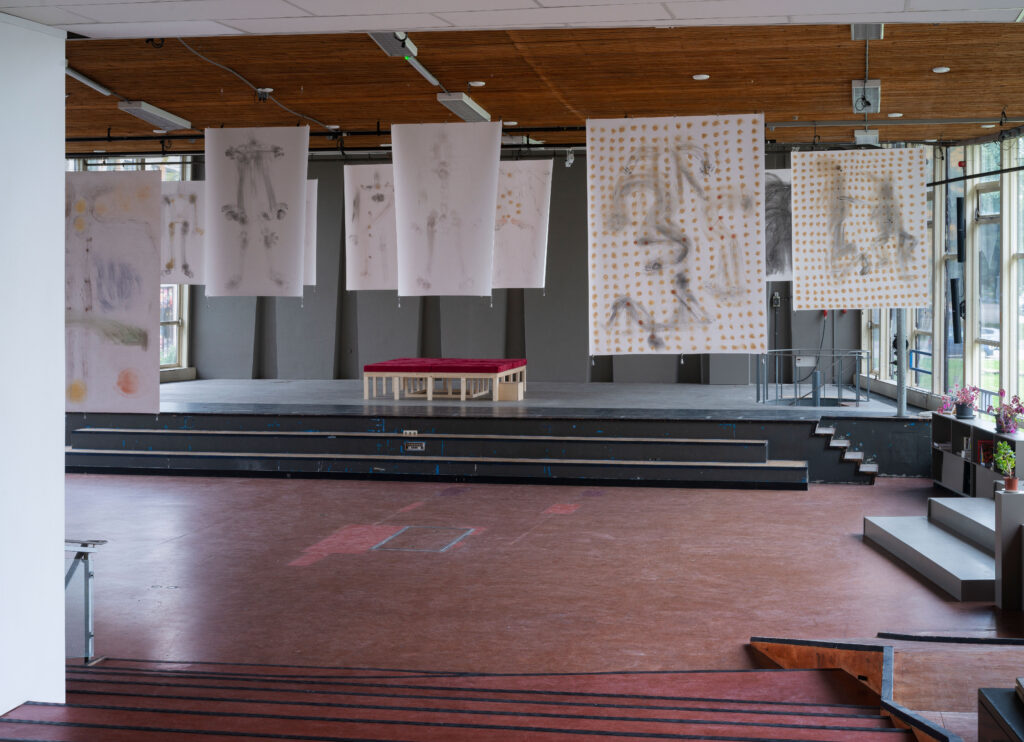OPEN CALL | IASI Individual self-recovery sessions with visual artist Georgia Sagri | space of togetherness
JULY 30 – AUGUST 20, 2024
APPLICATIONS
Letter of interest approx. 200 words submitted only via email to iasi.georgiasagri@gmail.com
DEADLINE
20 August 2024
There is no participation fee.
Georgia Sagri invites interested participants in a series of individual sessions as part of her work IASI. The work is included in NEON’s group exhibition space of togetherness.
IASI is her ongoing research project, part of Sagri’s artistic practice, which began ten years ago and evolves in her studio, ΥΛΗ[matter]HYLE in Athens. As part of her personal research, she conducts individual sessions with participants who have responded to an open call. These sessions are based on techniques she employs for preparation and recovery from her performances, utilizing breathing, movement, and vocal training.
The sessions take place on a specially designed soft stage, both a sculpture and a welcoming space, a kind of shell. The necessity of the “stage of recovery” stems from Georgia Sagri’s belief that “we all live our lives on stage, performing endlessly. The Stage of Recovery is a space where participants can, for a while, free themselves from the need to perform for others and themselves. There, they can feel safe and liberated from any audience.”
As part of the post-session process, Sagri uses sensory impressions of accumulated bodily experiences as references to create her works and capture the body’s memory.
The sessions are based on confidentiality and trust between the artist and the participants. They are not recorded and are not open to the public. They are conducted in a designated space at the Drama School of the National Theatre.
APPLICATION PROCESS
Those wishing to participate are invited to submit a letter of interest of approximately 200 words via email to iasi.georgiasagri@gmail.com by August 20th, stating their reasons for wanting to participate. From this process, Georgia Sagri will select ten individuals.
An important element of participation in IASI is the commitment and willingness of the participants to collaborate with the artist in developing their own recovery techniques.
Each participant will sign a collaboration agreement with the artist and will conduct three 40-minute sessions during the exhibition period, specifically from September 10th – October 18th, 2024, from Wednesday to Friday, from 12 to 3 pm.
There is no participation fee.
OPEN CALL: IASI
One-to-one sessions on self-care and recovery by artist Georgia Sagri
November 2022, Gropius Bau
As part of the group exhibition YOYI! Care, Repair and Heal, Georgia Sagri’s research practice IASI, on self-care and recovery continues to unfold at the Gropius Bau. This November, Sagri invites the public to take part in a series of private one-to-one sessions addressing the pathologies of the current time; what the artist refers to as performance pathologies. Her research begins with questions that seem almost too basic to pose: Do you notice your breath? How well do you breathe? How can you inhale as fully as you exhale? How can you give as much as you take? These slowly deepen into unique moments of sharing and healing.
IASI expands on more than ten years of Sagri’s experience in performance developing a series of treatments drawing on voice tuning, breathing techniques and movement. In her own words, she identifies her role in:
“…supporting, listening and navigating with each participant the compass of their discomfort, and its causes and effects. The treatments are approached as a creative practice, in which we work together through voice, gesture and movement techniques. Each participant will find movements and behaviours that allow them to learn from their pain, become stronger and empowered, and facilitate the potential of further self-recovery.”
While IASI sessions are fully confidential, the artist has developed a system for recording what she learns in each session so participants remain anonymous when these findings are shared with the public. The exhibition YOYI! Care, Repair and Heal shows four of her full-bodied charcoal drawings that act like traces or scores of the exchanges from previous sessions.
At the center of Georgia Sagri‘s (b. 1979) artistic practice lies in the exploration of performance as an ever-evolving field within social and visual life. It is interconnected, though distinct from the dialectics of representation in theater, music and dance. In addition to performance pieces, a large part of her artistic output comprises sculpture, video and digital media, installation, writing and drawing. In 2015 Sagri founded her studio YΛΗ[matter]HYLE, as a semi-public space in the centre of Athens that brings together art, politics and sciences. Her book Stage of Recovery was published by Divided Publishing in 2021.
Application
To apply, please send a letter of interest (approx. 200 words) in an e-mail to iasi.georgiasagri@gmail.com until 20.10.2022
One of the most important criteria for participating in IASI is commitment and willingness to work together with the artist on developing your own recovery techniques.
Applicants need to be available for two sessions per week for the duration of three weeks. Each session lasts max. 40 minutes.
All sessions take place in a private room at the Gropius Bau from 9.11.–28.11.2022 during the opening hours, Mon / Wed / Fri / Sat / Sun 10:00–19:00, Thu 10:00–21:00.
Selection Process for Participation
Georgia Sagri herself reads the letters of interest. Based on the stated interest she will conduct preliminary online conversations in English, with possible participants in the last week of October.
About 10-15 participants will participate in the one-to-one sessions. All the sessions will take place individually with the artist only.
All final notices as well as a schedule of the sessions will be sent out via e-mail by the end of October.
The sessions start from November 9th onwards. Exact dates will be confirmed with Georgia Sagri.
Accessibility
All sessions take place at the Gropius Bau in a private room on the Stage of Recovery, a sculpture made out of wood and covered by four large mattress-like pillows measuring 250 x 250 x 56 cm. During the session, the participant is mostly alone on the stage and has enough space to work through the different techniques. Georgia Sagri speaks English and Greek. If you require any other translation, please let the artists know in your letter of interest. The Gropius Bau’s spaces are accessible for people with limited mobility. Please state your access needs to allow arrangements to be made. Please follow this link for Access and Arrival information.
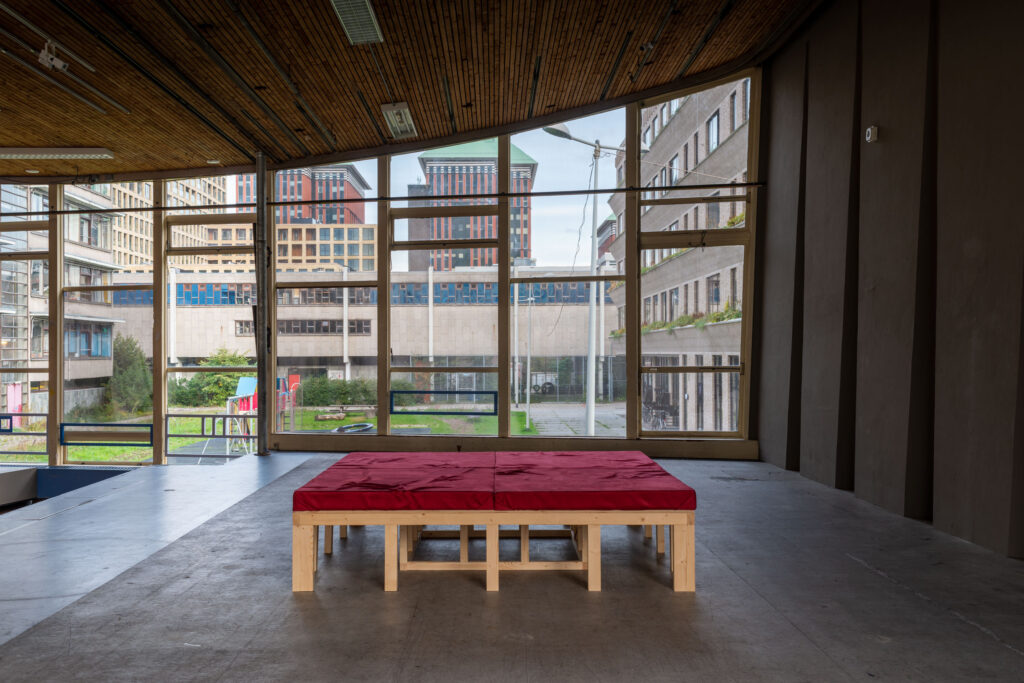
STAGE OF RECOVERY
While taking care of the breath, the voice starts to sound as it is formed and the whole world starts to vibrate differently. By breathing, singing or talking, the voice travels inside the body, touches the organs and colors them through vibration. Some voices, which means some bodies, are under shock; by altering the resonance of the voice, the body starts to vibrate differently, so some of the organs, that are in pain will start to recuperate.
For more than a decade, I have anchored my artistic practice through the development of a self-care routine based on breathing, movement, and voice that helped and still helps me to experiment and prepare for performance works. This practice became the basis for my work Dynamis, featured at documenta 14 (Kassel and Athens, 2017), which involved sharing these techniques with over 200 members of the public across the two cities. During this process, I responded to the public’s need and I decided to engage in a deeper understanding of self-recovery that gradually evolved into IASI (recovery), an ongoing research practice and a body of treatments conducted in one-to-one sessions with a protocol of anonymity.
Starting as my need to recover from physically and mentally demanding performance pieces, IASI became a research on the physiological and pathological conditions of the body in the globalized society, doomed to autoimmune illnesses, stress, discomfort, insomnia, panic attack, anxiety, fatigue, nausea, food disorder, mania, paranoia, arthritis, depression, addiction, to name some.
The formation of the practice unfolds in two interrelated parts: the first consists of private and anonymous one-to-one sessions, with a number of participants involved in the research. Their documentation is conducted with written texts, lectures and performances, in order to create a living record and to visually report the research practice and the content of the different case studies. The second part is the full-bodied charcoal drawings realized through the acquired exchange and information by the one-on-one sessions. These function as physical, practical memory traces, and as “sensorial references”, “affective imprints” and as scores for the continuing treatments. They can also be apprehended as paintings, archiving an energetic public recourse.
The Stage of Recovery is a sculpture made out of wood and the place where the sessions are conducted. It has the average size of a small stage, 250cm by 250cm and 65cm height. Four large thick pillows covered with cotton fabric are attached to the base, which remains stable. During the session the participant is on stage, mostly alone, and has enough space to work through the different techniques. Even though most of them have declared that they are “performing well” in their daily life, through my guidance they slowly realize, observe and work on the condition that makes them feel pain and sick. I am around the Stage of Recovery and I see what is going on, how the movements are progressing. Sometimes I will ask the participant to repeat a technique, to continue, to take time and to rest. The participant expects that the Stage of Recovery is soft because the techniques are hard. Quite the opposite, the Stage of Recovery is soft to recall that there is a soft and easy place to recover their tensions. Putting each session on stage – on what was the topos of the theater, where the construction of the social definitions took place – I aim to release social roles and behavioural self-policing. The intimate technique of observation happens with the training of the voice, focusing, in opposition to psychoanalysis, in how the voice sounds, and not in what it says. I follow and support each participant to tune differently as well as to experience another interiority of their body and through that tuning to become physically stronger and better. The participants learn from their physical state and find movements, and perhaps even a new voice, that will likely help them to self-recover. I have felt their bodies trembling for fear of touch. I have seen their tears when breathing at their own pace makes them feel better and when they realize that the pain they feel is not in their head, that it actually exists. I have seen the relief on their faces when I tell them that they don’t need to do anything during the session: They can just be.

Order a copy of the book Stage of Recovery here
If you are interested in booking a private one-to-one session, for the next round of IASI, please contact georgiasagristudio@gmail.com
In early 2020, IASI was conducted in London at Mimosa House and, during the pandemic, has continued online in Athens and then in the physical space at TAVROS. From September until January 2021 IASI was conducted at DeAppel in Amsterdam.
Mimosa House, London
The collaboration with Mimosa House is Georgia Sagri’s first institutional exhibition in the UK, and is also the inauguration of her research practice IASI, and her long-term commitment to working directly with the public. This chapter of her research is being developed in overlapping phases across three international organisations, each of which will host Sagri’s one-to-one sessions, research and respective case studies. The organisations are Mimosa House in the United Kingdom, t a v r o s in Greece, and De Appel in the Netherlands.
In February 2020, Sagri introduced her project IASI at Mimosa House, in conversation with institutional allies Daria Khan (Mimosa House, United Kingdom), Maria-Thalia Carras (TAVROS, Greece), and Monika Szewczyk (De Appel, The Netherlands) – a video of the conversation is available to view here
Addressing the pathologies of our time, Georgia Sagri identifies her role in this process:
… to support, listen and navigate with each participant the compass of their discomfort, and its causes and effects. The treatments are approached as a creative practice, in which we work together through voice, gesture and movement techniques. Each participant will find movements and behaviours that allow them to learn from their pain, become stronger and empowered, and facilitate the potential of further self-recovery
On the project, curator and Mimosa House founder Daria Khan has said:
Georgia Sagri’s ‘IASI’ brings a unique and new opportunity to Mimosa House: to explore the impact of artistic practice on the public, as well as to ask wider questions about artist labour, self-care and pathologies of our time. ‘IASI’ is an experiment in establishing in-depth collaboration with individual members of the audience, through a process of sharing knowledge and bodily practice which have a long lasting effect beyond the exhibition’s timeframe and space.
Tavros, Athens
IASI begins at the start of us all. Our breathing bodies.
Few of us really comprehend how much we limit our breath. How much we limit our living. Our ability to take in the world and to inhale, this our ultimate most vital act of sharing; in turn, as we exhale, perhaps our most generous act of giving. This rhythmic circularity has been interrupted as we seemingly gasp for air: the reverberations are political and existential. How much oxygen are we allowed in a world going up in flames? Stifled, unable to breathe, and speak, not just for the sake of the words but in order to be heard.
IASI, Georgia Sagri’s ongoing research practice which started almost ten years ago in the form of self-training and which continues at her studio and artist run space Ύλη[matter]HYLE in Athens, now takes on a new form of one-on-one sessions with participants that have responded to an open call. These sessions are based on physical techniques that use breath as an active agent, movement and voice training.

The sessions, two or three times a week over a period of two months, are private. Intensely so. They take place on a specially designed soft stage, an art object but also a welcoming place, a shell of sorts. This “stage of recovery” is based on Georgia Sagri’s premise that, “we all live our lives on stage, endlessly performing. The “stage of recovery” is a place where the participants can, for a while, be freed from the necessity of performing to others and for themselves. It gives them the time to be safe and free from an audience.” Whatever shifts, releases or movements occur in these private interchanges remains undisclosed. Unrepresented; still, they are.
New forms however demand new languages, and with IASI, Sagri sets the terms of the game. At the crossroads between activism, performance and self-recovery, this new phase in her practice is also a quest for an appropriate wording. Bodies in IASI birth their own cosmologies, circumventing scientific and empirical terminologies and allowing for intuited responses. Following each session Sagri summarizes written reports whose origin lies in the liminal moments of a body in treatment. Language, terminologies, rules, time-lapse as new forms of existing appear as fragile intermediaries between the then and the now. IASI is nothing less then, than a search for a new vocabulary, an original script for a new way of being and a movement for caring of oneself and others. IASI is also a search for new formats, where time is given and taken for reflection and research, where what is visible and what isn’t, is to be seen.
Following the sessions, Sagri, using all her tactile forces, colors out primal imprints, like memory skins. This series of visual impressions of the accumulated bodily experiences (chronic pains and releases) form, alongside the reports and performances, the formal backbone of the resulting exhibition. Throughout the duration of the exhibition there will be sense of perennial impermanence with works by Georgia Sagri appearing or shifting, hinting at constantly fluctuating temporalities, with each work re-contextualized each time in dialogue with each other. The exhibition will itself be a living form, dilating and compressing, even holding its breath in between.
This new chapter of her research will develop in overlapping phases in three art institutions and three cities – Mimosa House (London), TAVROS (Athens), De Appel (Amsterdam) and at her studio ‘Υλη[matter]HYLE – knowledge accrued from one location will be carried to the next, enriching the process. Sagri’s presence in these concurrent spaces will mirror the constant disembodiment in the multiplicity of images (our split screen personalities) with which we diffuse and ‘read’ ourselves. Georgia Sagri, adept at loops, here includes this circularity as part of the very form of her research. Instead of performing in large concentric circles, connectivity in all three locations will be personal. One step at a time. One breath at a time, reaching out.
It is this prescient demand for human contact and for a new social contract that brings IASI here to TAVROS. Reflecting our belief that art might no longer concern purely material exchange but will return to other value systems that use action to counter worldly and somatic alienation and that our bodies still have the capacity to rewire, release and be receptive to care and love. IASI provides the basis for a discussion on bodies (as celestial as they are mundane), stillness (through abstention) and voice (as the precondition for political beings). Our pain and subjectivity is removed from the world of things but as it surfaces collectively we have the chance to start on a process of recovery and perhaps a new chapter of living.
Breath, after all is urgent. Bodies, after all are beautiful.
de Appel, Amsterdam
The first element built for the exhibition is a soft stage – a functional sculpture designed by Georgia Sagri especially for the one-on-one sessions of IASI. It is a modular sculpture with versions at Mimosa House in London and Tavros in Athens. While the specific scale of an oversized bed remains constant in all locations, the artist chooses differently dyed fabric to suit each setting. At de Appel, the deep crimson stage rests on top of the existing stage of the iconic Aula at Broedplaats Lely (formerly Pascal College, built in 1969 by Ben Ingwersen). The installation might give visitors a sense of the recovery of this public theatrical space for the purpose of personal strengthening. The perfect acoustics of the Aula further enhance the reclamation of breath and voice that lie at the heart of Sagri’s approach.

Hanging high in the spacious Aula are Sagri’s full-bodied drawings. The charcoal and chalk pastels applied by the artist’s hands record the exchange of information and energy from the one-on-one sessions in Amsterdam. Together with those created from past sessions in London and in Athens, these drawings function as practical memory traces, as “sensorial references” and as scores for the continuing treatments. They can be apprehended as individual images and as a collective.
During the exhibition, materials from the evolving history of performance art dating back to the 1970s, found in de Appel’s Archive, add depth and historical context to Sagri’s pivotal practice. As this evocative ephemera enters into a dialogue with Sagri’s modular stage-sculpture and full-bodied drawings. Here, a number of questions arise:
What is/has been the artist’s role in society?
What is/has been the role of the public?
Can we conceive of performance art without a sense of spectacle?
What traditions of theater and/as therapy remain to be recovered?
How do we breathe better together?
